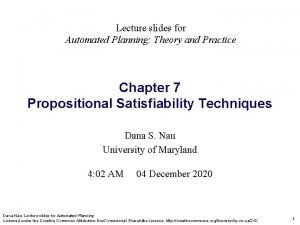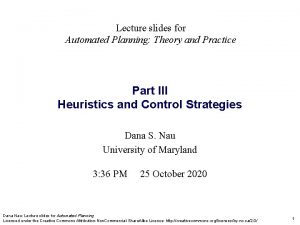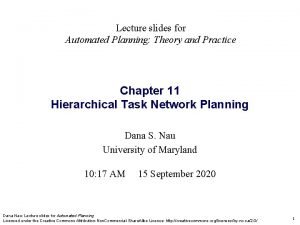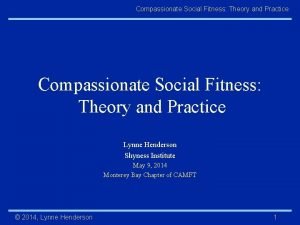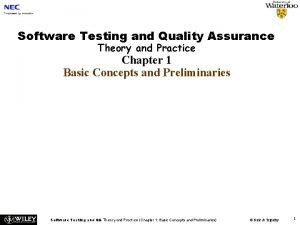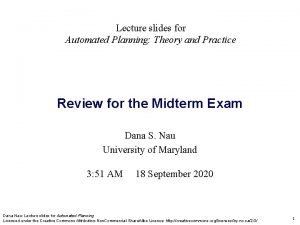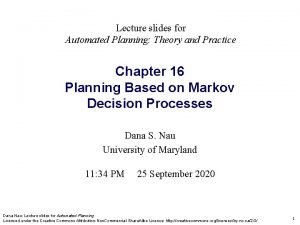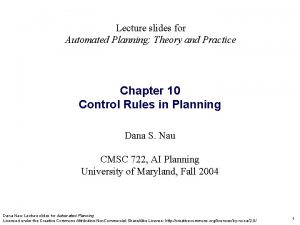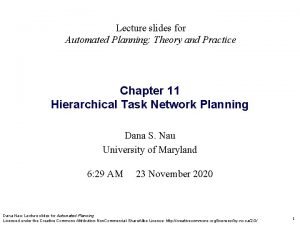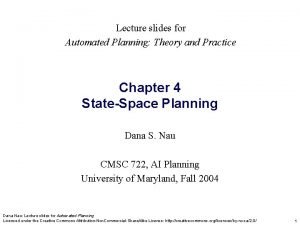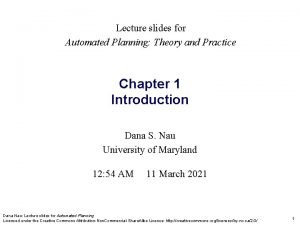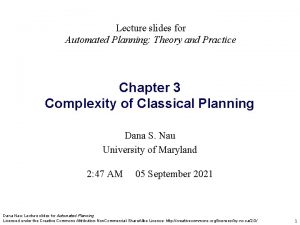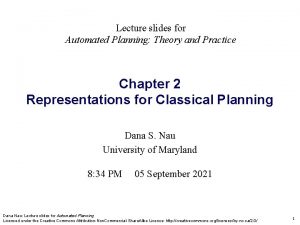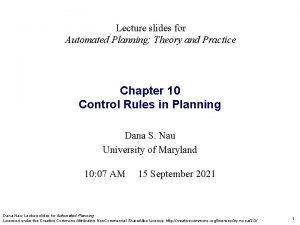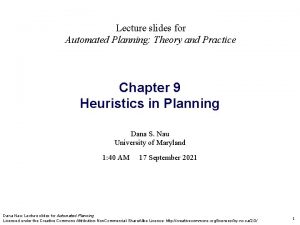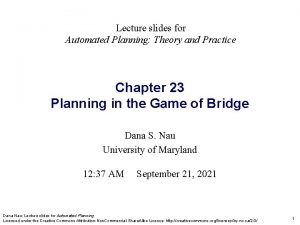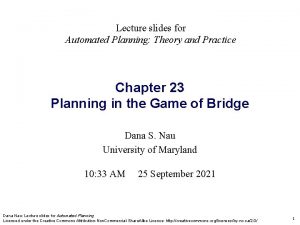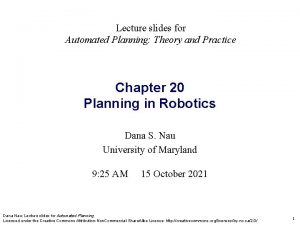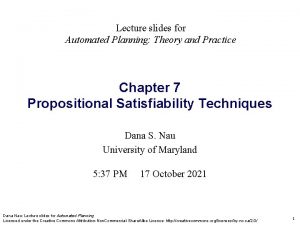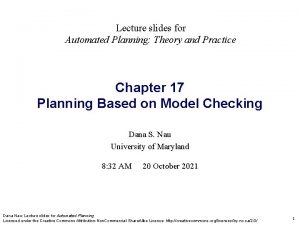Lecture slides for Automated Planning Theory and Practice





















- Slides: 21

Lecture slides for Automated Planning: Theory and Practice Chapter 7 Propositional Satisfiability Techniques Dana S. Nau University of Maryland 4: 02 AM 04 December 2020 Dana Nau: Lecture slides for Automated Planning Licensed under the Creative Commons Attribution-Non. Commercial-Share. Alike License: http: //creativecommons. org/licenses/by-nc-sa/2. 0/ 1

Motivation Propositional satisfiability: given a boolean formula » e. g. , (P Q) ( Q R S) ( R P), does there exist a model » i. e. , an assignment of truth values to the propositions that makes the formula true? This was the very first problem shown to be NP-complete Lots of research on algorithms for solving it Algorithms are known for solving all but a small subset in average-case polynomial time Therefore, Try translating classical planning problems into satisfiability problems, and solving them that way Dana Nau: Lecture slides for Automated Planning Licensed under the Creative Commons Attribution-Non. Commercial-Share. Alike License: http: //creativecommons. org/licenses/by-nc-sa/2. 0/ 2

Outline Encoding planning problems as satisfiability problems Extracting plans from truth values Satisfiability algorithms Davis-Putnam Local search GSAT Combining satisfiability with planning graphs Sat. Plan Dana Nau: Lecture slides for Automated Planning Licensed under the Creative Commons Attribution-Non. Commercial-Share. Alike License: http: //creativecommons. org/licenses/by-nc-sa/2. 0/ 3

Overall Approach A bounded planning problem is a pair (P, n): P is a planning problem; n is a positive integer Any solution for P of length n is a solution for (P, n) Planning algorithm: Do iterative deepening like we did with Graphplan: for n = 0, 1, 2, …, » encode (P, n) as a satisfiability problem » if is satisfiable, then • From the set of truth values that satisfies , a solution plan can be constructed, so return it and exit Dana Nau: Lecture slides for Automated Planning Licensed under the Creative Commons Attribution-Non. Commercial-Share. Alike License: http: //creativecommons. org/licenses/by-nc-sa/2. 0/ 4

Notation For satisfiability problems we need to use propositional logic Need to encode ground atoms into propositions For set-theoretic planning we encoded atoms into propositions by rewriting them as shown here: » Atom: at(r 1, loc 1) » Proposition: at-r 1 -loc 1 For planning as satisfiability we’ll do the same thing But we won’t bother to do a syntactic rewrite Just use at(r 1, loc 1) itself as the proposition Also, we’ll write plans starting at a 0 rather than a 1 π = a 0, a 1, …, an– 1 Dana Nau: Lecture slides for Automated Planning Licensed under the Creative Commons Attribution-Non. Commercial-Share. Alike License: http: //creativecommons. org/licenses/by-nc-sa/2. 0/ 5

Fluents If π = a 0, a 1, …, an– 1 is a solution for (P, n), it generates these states: s 0, s 1 = (s 0, a 0), s 2 = (s 1, a 1), …, sn = (sn– 1, an– 1) Fluent: proposition saying a particular atom is true in a particular state at(r 1, loc 1, i) is a fluent that’s true iff at(r 1, loc 1) is in si We’ll use li to denote the fluent for literal l in state si » e. g. , if l = at(r 1, loc 1) then li = at(r 1, loc 1, i) ai is a fluent saying that a is the i’th step of π » e. g. , if a = move(r 1, loc 2, loc 1) then ai = move(r 1, loc 2, loc 1, i) Dana Nau: Lecture slides for Automated Planning Licensed under the Creative Commons Attribution-Non. Commercial-Share. Alike License: http: //creativecommons. org/licenses/by-nc-sa/2. 0/ 6

Encoding Planning Problems Encode (P, n) as a formula such that π = a 0, a 1, …, an– 1 is a solution for (P, n) if and only if can be satisfied in a way that makes the fluents a 0, …, an– 1 true Let A = {all actions in the planning domain} S = {all states in the planning domain} L = {all literals in the language} is the conjunct of many other formulas … Dana Nau: Lecture slides for Automated Planning Licensed under the Creative Commons Attribution-Non. Commercial-Share. Alike License: http: //creativecommons. org/licenses/by-nc-sa/2. 0/ 7

Formulas in 1. Formula describing the initial state: /{l 0 | l s 0} /{ l 0 | l L – s 0 } 2. Formula describing the goal: /{ln | l g+} /{ ln | l g–} 3. For every action a in A and for i = 1, …, n, a formula describing what changes a would make if it were the i’th step of the plan: ai /{pi | p Precond(a)} / {ei+1 | e Effects(a)} 4. Complete exclusion axiom: For every pair of actions a and b, and for i = 0, …, n– 1, a formula saying they can’t both be the i’th step of the plan ai bi this guarantees there can be only one action at a time Is this enough? Dana Nau: Lecture slides for Automated Planning Licensed under the Creative Commons Attribution-Non. Commercial-Share. Alike License: http: //creativecommons. org/licenses/by-nc-sa/2. 0/ 8

Frame Axioms 5. Frame axioms: Formulas describing what doesn’t change between steps i and i+1 Several ways to write these One way: explanatory frame axioms For i = 0, …, n– 1, an axiom for every literal l » Says that if l changes between si and si+1, then the action at step i must be responsible: ( li li+1 Va in A{ai | l effects+(a)}) (li li+1 Va in A{ai | l effects–(a)}) Dana Nau: Lecture slides for Automated Planning Licensed under the Creative Commons Attribution-Non. Commercial-Share. Alike License: http: //creativecommons. org/licenses/by-nc-sa/2. 0/ 9

Example Planning domain: one robot r 1 two adjacent locations l 1, l 2 one planning operator (to move the robot from one location to another) Encode (P, n) where n = 1 1. Initial state: Encoding: {at(r 1, l 1)} at(r 1, l 1, 0) at(r 1, l 2, 0) 2. Goal: Encoding: {at(r 1, l 2)} at(r 1, l 2, 1) at(r 1, l 1, 1) 3. Operator: see next slide Dana Nau: Lecture slides for Automated Planning Licensed under the Creative Commons Attribution-Non. Commercial-Share. Alike License: http: //creativecommons. org/licenses/by-nc-sa/2. 0/ 10

Example (continued) Operator: move(r, l, l' ) precond: at(r, l) effects: at(r, l' ), at(r, l) Encoding: move(r 1, l 2, 0) at(r 1, l 1, 0) at(r 1, l 2, 1) at(r 1, l 1, 1) move(r 1, l 2, l 1, 0) at(r 1, l 2, 0) at(r 1, l 1, 1) at(r 1, l 2, 1) move(r 1, l 1, 0) at(r 1, l 1, 1) contradictions move(r 1, l 2, 0) at(r 1, l 2, 1) (easy to detect) move(l 1, r 1, l 2, 0) … nonsensical, and we can avoid generating move(l 2, l 1, r 1, 0) … them if we use data types like we did for move(l 1, l 2, r 1, 0) … state-variable representation move(l 2, l 1, r 1, 0) … Operator: move(r : robot, l : location, l' : location) precond: at(r, l) effects: at(r, l' ), at(r, l) Dana Nau: Lecture slides for Automated Planning Licensed under the Creative Commons Attribution-Non. Commercial-Share. Alike License: http: //creativecommons. org/licenses/by-nc-sa/2. 0/ 11

Example (continued) 4. Complete-exclusion axiom: move(r 1, l 2, 0) move(r 1, l 2, l 1, 0) 5. Explanatory frame axioms: at(r 1, l 1, 0) at(r 1, l 1, 1) move(r 1, l 2, l 1, 0) at(r 1, l 2, 0) at(r 1, l 2, 1) move(r 1, l 2, 0) at(r 1, l 1, 0) at(r 1, l 1, 1) move(r 1, l 2, 0) at(r 1, l 2, 0) at(r 1, l 2, 1) move(r 1, l 2, l 1, 0) is the conjunct of all of these Dana Nau: Lecture slides for Automated Planning Licensed under the Creative Commons Attribution-Non. Commercial-Share. Alike License: http: //creativecommons. org/licenses/by-nc-sa/2. 0/ 12

Summary of the Example P is a planning problem with one robot and two locations initial state {at(r 1, l 1)} goal {at(r 1, l 2)} Encoding of (P, 1) = [at(r 1, l 1, 0) at(r 1, l 2, 0)] (initial state) [at(r 1, l 2, 1) at(r 1, l 1, 1)] (goal) [move(r 1, l 2, 0) at(r 1, l 1, 0) at(r 1, l 2, 1) at(r 1, l 1, 1)] [move(r 1, l 2, l 1, 0) at(r 1, l 2, 0) at(r 1, l 1, 1) at(r 1, l 2, 1)] [ move(r 1, l 2, 0) move(r 1, l 2, l 1, 0)] [ at(r 1, l 1, 0) at(r 1, l 1, 1) move(r 1, l 2, l 1, 0)] [ at(r 1, l 2, 0) at(r 1, l 2, 1) move(r 1, l 2, 0)] [at(r 1, l 1, 0) at(r 1, l 1, 1) move(r 1, l 2, 0)] [at(r 1, l 2, 0) at(r 1, l 2, 1) move(r 1, l 2, l 1, 0)] (action) (complete exclusion) (frame axiom) Dana Nau: Lecture slides for Automated Planning Licensed under the Creative Commons Attribution-Non. Commercial-Share. Alike License: http: //creativecommons. org/licenses/by-nc-sa/2. 0/ 13

Extracting a Plan Let be an encoding of (P, n) Suppose we find an assignment of truth values that satisfies . This means P has a solution of length n For i=1, …, n, there will be exactly one action a such that ai = true This is the i’th action of the plan. Example The formula on the previous slide can be satisfied with move(r 1, l 2, 0) = true » Thus move(r 1, l 2, 0) is a solution for (P, 1) It’s the only solution - no other way to satisfy Dana Nau: Lecture slides for Automated Planning Licensed under the Creative Commons Attribution-Non. Commercial-Share. Alike License: http: //creativecommons. org/licenses/by-nc-sa/2. 0/ 14

Planning How to find an assignment of truth values that satisfies ? Use a satisfiability algorithm Example: the Davis-Putnam algorithm First need to put into conjunctive normal form e. g. , = D ( D A B) A Write as a set of clauses (disjuncts of literals) = {{D}, { D, A, B}, { D, A, B}, {A}} Some special cases: » If = then is always true » If = {…, , …} then is always false (hence unsatisfiable) » If contains a unit clause, l, then l must be true in order to satisfy Dana Nau: Lecture slides for Automated Planning Licensed under the Creative Commons Attribution-Non. Commercial-Share. Alike License: http: //creativecommons. org/licenses/by-nc-sa/2. 0/ 15

The Davis-Putnam Procedure Backtracking search through alternative assignments of truth values to literals = {literals to which we have assigned the value TRUE} initially empty For every unit clause l Unit-propagate( , ) add l to if then return error in the book here if = then exit with remove clauses that contain l modify clauses that contain l If contains , fails If = , is a solution Select a Boolean variable P in do two recursive calls P P Dana Nau: Lecture slides for Automated Planning Licensed under the Creative Commons Attribution-Non. Commercial-Share. Alike License: http: //creativecommons. org/licenses/by-nc-sa/2. 0/ 16

Local Search Let u be an assignment of truth values to all of the variables cost(u, ) = number of clauses in that aren’t satisfied by u flip(P, u) = u except that P’s truth value is reversed Boolean variable Local search: Select a random assignment u while cost(u, ) ≠ 0 » if there is a P such that cost(flip(P, u), ) < cost(u, ) then • randomly choose any such P • u flip(P, u) » else return failure Local search is sound If it finds a solution it will find it very quickly Local search is not complete: can get trapped in local minima Dana Nau: Lecture slides for Automated Planning Licensed under the Creative Commons Attribution-Non. Commercial-Share. Alike License: http: //creativecommons. org/licenses/by-nc-sa/2. 0/ 17

GSAT Basic-GSAT: Select a random assignment u while cost(u, ) ≠ 0 » choose a P that minimizes cost(flip(P, u), ), and flip it Not guaranteed to terminate GSAT: restart after a max number of flips return failure after a max number of restarts The book discusses several other stochastic procedures One is Walksat » works better than both local search and GSAT I’ll skip the details Dana Nau: Lecture slides for Automated Planning Licensed under the Creative Commons Attribution-Non. Commercial-Share. Alike License: http: //creativecommons. org/licenses/by-nc-sa/2. 0/ 18

Discussion Recall the overall approach: for n = 0, 1, 2, …, » encode (P, n) as a satisfiability problem » if is satisfiable, then • From the set of truth values that satisfies , extract a solution plan and return it By itself, not very practical (takes too much memory and time) But it can work well if combined with other techniques e. g. , planning graphs Dana Nau: Lecture slides for Automated Planning Licensed under the Creative Commons Attribution-Non. Commercial-Share. Alike License: http: //creativecommons. org/licenses/by-nc-sa/2. 0/ 19

Sat. Plan combines planning-graph expansion and satisfiability checking Works roughly as follows: for k = 0, 1, 2, … » Create a planning graph that contains k levels » Encode the planning graph as a satisfiability problem » Try to solve it using a SAT solver • If the SAT solver finds a solution within some time limit, - Remove some unnecessary actions - Return the solution Memory requirement still is combinatorially large but less than what’s needed by a direct translation into satisfiability Black. Box (predecessor to Sat. Plan) was one of the best planners in the 1998 planning competition Sat. Plan was one of the best planners in the 2004 and 2006 planning competitions Dana Nau: Lecture slides for Automated Planning Licensed under the Creative Commons Attribution-Non. Commercial-Share. Alike License: http: //creativecommons. org/licenses/by-nc-sa/2. 0/ 20

Other Translation Approaches Translate planning problems into 0 -1 integer programming problems Then solve them using an integer programming package such as CPLEX Techniques are somewhat similar to translation of planning to satisfiability Translate planning problems into constraint satisfaction problems Then solve them using CSP techniques such as arc consistency and path consistency For details, see Chapter 8 Dana Nau: Lecture slides for Automated Planning Licensed under the Creative Commons Attribution-Non. Commercial-Share. Alike License: http: //creativecommons. org/licenses/by-nc-sa/2. 0/ 21
 Automated planning theory and practice
Automated planning theory and practice Automated planning theory and practice
Automated planning theory and practice Automated planning theory and practice
Automated planning theory and practice A small child slides down the four frictionless slides
A small child slides down the four frictionless slides A hockey puck sliding on smooth ice at 4 m/s
A hockey puck sliding on smooth ice at 4 m/s Principles of economics powerpoint lecture slides
Principles of economics powerpoint lecture slides Machine learning slides
Machine learning slides Business communication lecture slides
Business communication lecture slides 01:640:244 lecture notes - lecture 15: plat, idah, farad
01:640:244 lecture notes - lecture 15: plat, idah, farad Project planning and management lecture notes ppt
Project planning and management lecture notes ppt Land use planning lecture notes
Land use planning lecture notes Land economics lecture notes
Land economics lecture notes Land use planning '' lecture notes
Land use planning '' lecture notes Supply chain management and total quality management ppt
Supply chain management and total quality management ppt Practice assessor feedback examples
Practice assessor feedback examples Natural language processing nlp - theory lecture
Natural language processing nlp - theory lecture Decision theory lecture notes
Decision theory lecture notes Bayesian decision theory lecture notes
Bayesian decision theory lecture notes Natural language processing lecture notes
Natural language processing lecture notes Quality assurance theory
Quality assurance theory Social fitness training
Social fitness training The quality revolution
The quality revolution
